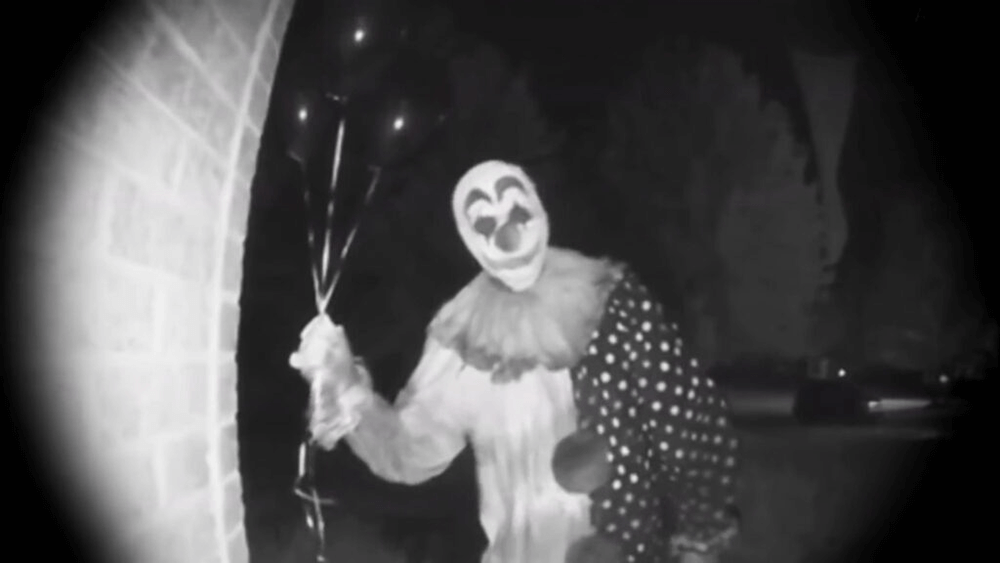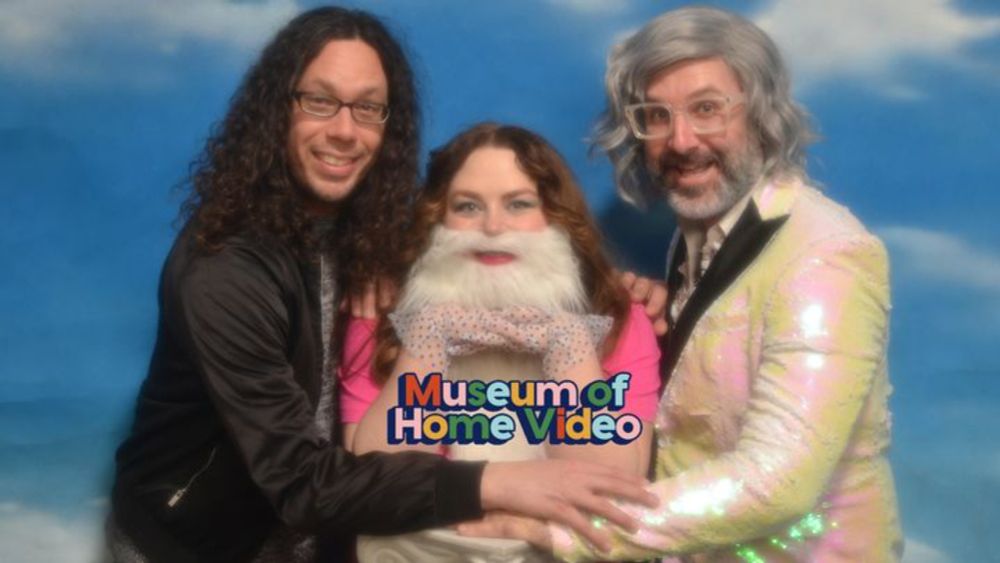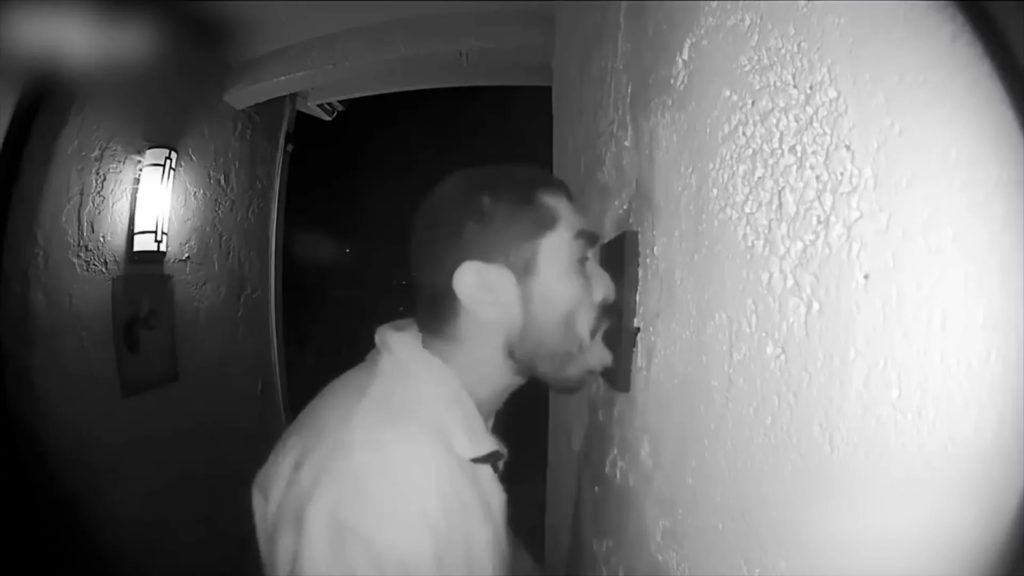|Penny Folger|

THE MUSEUM OF HOME VIDEO, LIVE AND IN PERSON! plays at the Trylon Cinema from Friday, March 15th, through Sunday, March 17th. Visit trylon.org for tickets and more information.
The Museum of Home Video is an online streaming show that took flight during the pandemic and seems to have created an empire. Started by Los Angeleno film programmer/distributor Brett Berg, it takes place at museumofhomevideo.com at 7:30 pm PST most Tuesday evenings. Since its inception in July 2020, it has created so much spin-off programming that the site has turned into its own channel, like a radio station where the curated content is video imagery instead of music.
Now, in this latest incarnation, it’s turned into an in-person traveling show, as Trylon welcomes MOHV’s special presentation Ring, Ring: a Doorbell Cam Fantasia (they’ll also be presenting an additional program entitled Museum of Home Video’s Guide to Infomercials which I have not seen, but knowing them, should also be delightfully entertaining).

But what exactly is the Museum of Home Video, you might ask? Defining just what it is is something Berg himself has admitted can be tricky. Said Berg in an interview last year, “The real problem with it is that it is difficult to explain. The longline that I like to use is ‘college radio for the eyes.’”1
Berg has also referred to it as “a weekly found footage variety show where the thesis is the history of showbiz.”2
A mix of old commercials, talk show bits, music videos, ancient TV news segments from other parts of the country, and bad movies where he’ll edit a two-hour runtime down to its most outrageous i.e. entertaining 15 minutes, the program has evolved over the past four years to feel like much more. It’s even gotten its share of guest curators with their own sensibilities to further liven things up.
A throughline for the show seems to be a sense of humor and awe when looking back at our recent past. It’s a bit like someone is curating segments of YouTube for you from a bygone era—bits that you’ll never see anywhere else. Says Berg, it’s “basically college radio meets channel surfing.”3
To give you more context into this traveling video circus that’s coming to your town, I will give you my personal history of witnessing some of Berg’s trajectory from afar, which I recently discovered I’ve been doing since as far back as 2007. I didn’t realize it at the time, but he programmed the movies I attended at LA’s now-defunct Cinefamily (previously The Silent Movie Theater) on a regular basis. He became eventual Director of Programming there after Hadrian Belove, co-owner of CineFile Video where Berg had worked previously, moved to take over the theater. (From a murder to an eventual sexual harassment scandal, the theater has its own long haunted history that you can Google but is far too involved to go into here.)
While I don’t know Berg personally, it dawned on me while writing this article that he seems to have had a small but surprisingly enduring impact on my life. LA being the small town it can be, we apparently even have a smattering of friends and acquaintances in common. It’s perhaps ironic that I’m reporting my impressions from Los Angeles of another Los Angeleno who will soon be traveling cross country to present programming to Trylon: like next-door neighbors who strangely run into each other only while traveling abroad.
After the Cinefamily closed in 2017, I became consciously aware of Berg for the first time when I attended the kickoff of his new project, the Voyager Institute, in August of that year.
The part of his presentation I can still recall—and I may have arrived late—was a slideshow on some of the lesser-known films of Robert Altman from the 1970s. Two weeks later, I attended another Voyager Institute program that included a panel of employees from independent video stores in Los Angeles—Berg himself, as previously mentioned, being a former employee of CineFile Video. It was at this screening that I reconnected with an old friend—a video store employee who was on the panel—who I hadn’t seen in 4 years.
But it was during the COVID lockdown that Berg really felt like he gained traction, with the Museum of Home Video. The program, like the Voyager Institute, was originally intended to be a live in-person show in June 2020, but had to pivot to the online streaming universe for obvious reasons. While I can’t recall how I initially became aware of the Voyager Institute, I was on the mailing list to hear the news of the MOHV by the time of its launch.
I found this press announcement dated July 16, 2020:
“Bret from Voyager Institute here. If you’re reading this, hopefully you’ve attended one of our live shows! Ever since 2000—when I first bought a hard drive—I’ve collected the history of showbiz. Everything from late-nite talk shows to MTV airchecks, unreleased films, forgotten TV series, stunning live performances, and other great bits.
“I’ve downloaded so much in my life, but only now have I started ‘watching’ it all. (Avid collectors, I think you know the feeling.) I’ve gotten so much joy from this that I had to share it with you.
“Starting Tuesday 7/28, 7:30pm, join me on Twitch for THE MUSEUM OF HOME VIDEO: your new found footage celebration. 90 minutes of the best from my stash, plus guest spots by friends from the world of collecting. Co-produced by my good friend Jenny Nixon.”
And so it was born.
The MOHV, as well as Cathode TV, which sprung from the Coaxial Arts Foundation in Los Angeles also during the COVID lockdown, were the two biggest programming streams I saw rise from the wild west of online streaming which gained momentum during lockdown. For those unfamiliar: “streaming” refers to video programming that is live-streamed, with the additional component of a community of online viewers who have the option to live chat while the program plays. In our age of on-demand, binge-watching, and platform subscriptions this format harkens back to television of a bygone era, when programs were broadcast live at specific times, with households watching simultaneously. These two streamers gained enough popularity that both were eventually thrown off the website Twitch for minor infractions I only saw happen to platforms that rose to a certain level of prominence. Both would move on to relaunch their streams from their own websites.
On any given night at the Museum of Home Video I’d see 200-300 other viewers, their online comments scrolling past as quickly and freneticaly as the programming itself. For me personally, it was one way to help stay psychologically engaged when it was impossible to engage with community in person.
That is one reason that when Ring Ring came to Los Angeles at the newly opened Vidiots theater last July, it felt so meaningful. This program we had all watched online while locked away in our homes for three years was suddenly happening in person. It was similar to being reunited with a friend you hadn’t seen since before the pandemic, only in this instance it was a friend you had never met who had, in part, helped you through it.
I cannot report as extensively on the contents of Ring Ring as I might with the more traditional films I write about here, where I will rewatch and do research on their making. Although everything above is, in a sense, the making of the programming that led to this event. Due to the hodgepodge nature of this kind of programming, combined with my age-ridden brain which needs to see something multiple times in order to comment upon it, there is also the fact that I can’t rewatch it at all. As a result I’m left more with my general impressions and the memory of the joy of the community experience.

In terms of the main event: a montage of strange things recorded by ring cameras—those doorbells that record video when someone approaches them—the overall feeling I walked away with was, “I’m glad I don’t own a house in a less populated region of the United States!” I live in Los Angeles, the biggest city in the country. While not as dense and compact as New York City, you also don’t feel like you’re going to be murdered like the Clutters in In Cold Blood in the middle of the night without anyone taking notice. Ring Ring reads like a horror film—strangers staring into ring cameras at 3 am—but what we’re viewing is reality, so I must give myself these reassurances. These things mostly happen in suburban regions of places like Florida and the Midwest, right…?
But the bigger takeaway from this program, other than its hilarity and frights, was the excitement of some of the people I’d inadvertently spent the past 3 years with coming together joyously in a theater, in person, as had been the intent of the Museum all along, thanks to Bret Berg and his collaborators. Hopefully whether you’re a longtime viewer or a first-time audience member, some of this joy and community will be imparted to you by the MOHV’s Minneapolis visitation.
- Homophilia, College Radio For The Eyes with Bret Berg, podcast audio, July 21, 2023. ↩︎
- Cinematic Void Podcast, Episode 77: Brett Berg of AGFA & Museum of Home Video, podcast audio, September 21, 2023. ↩︎
- Homophilia. ↩︎
Edited by Finn Odum
